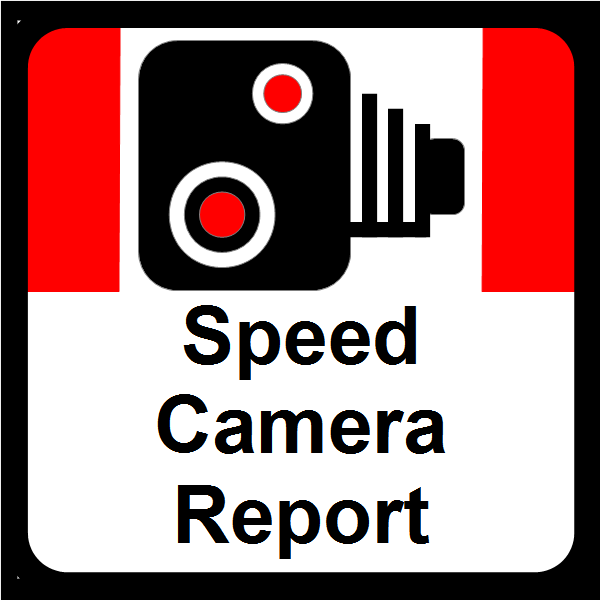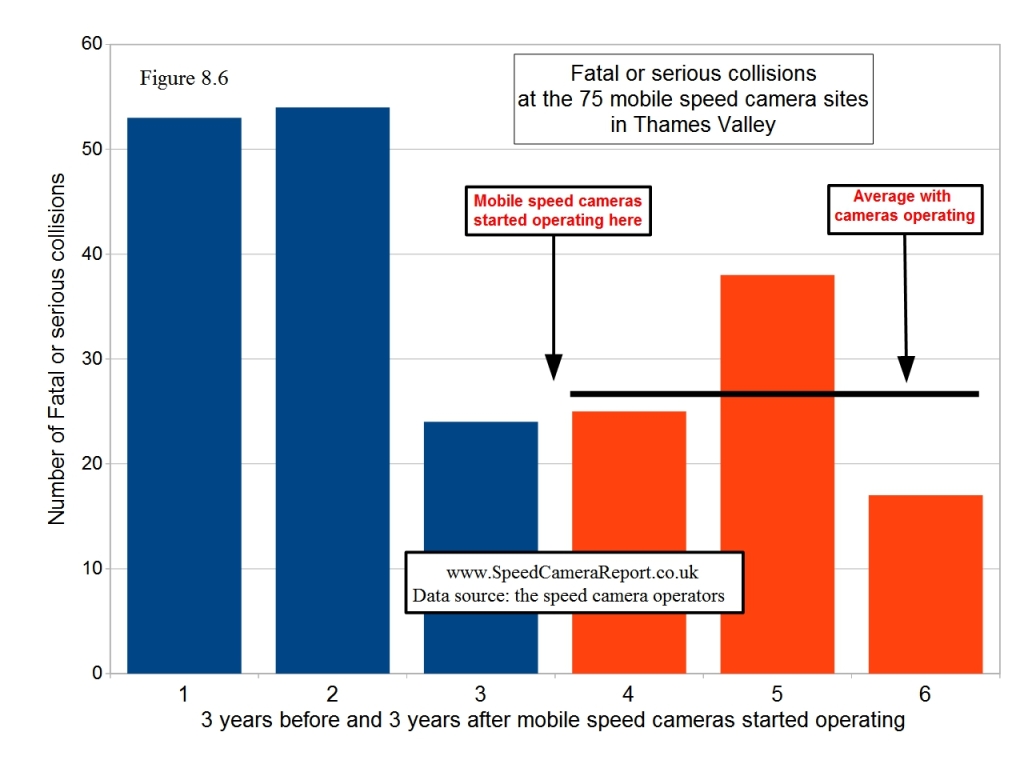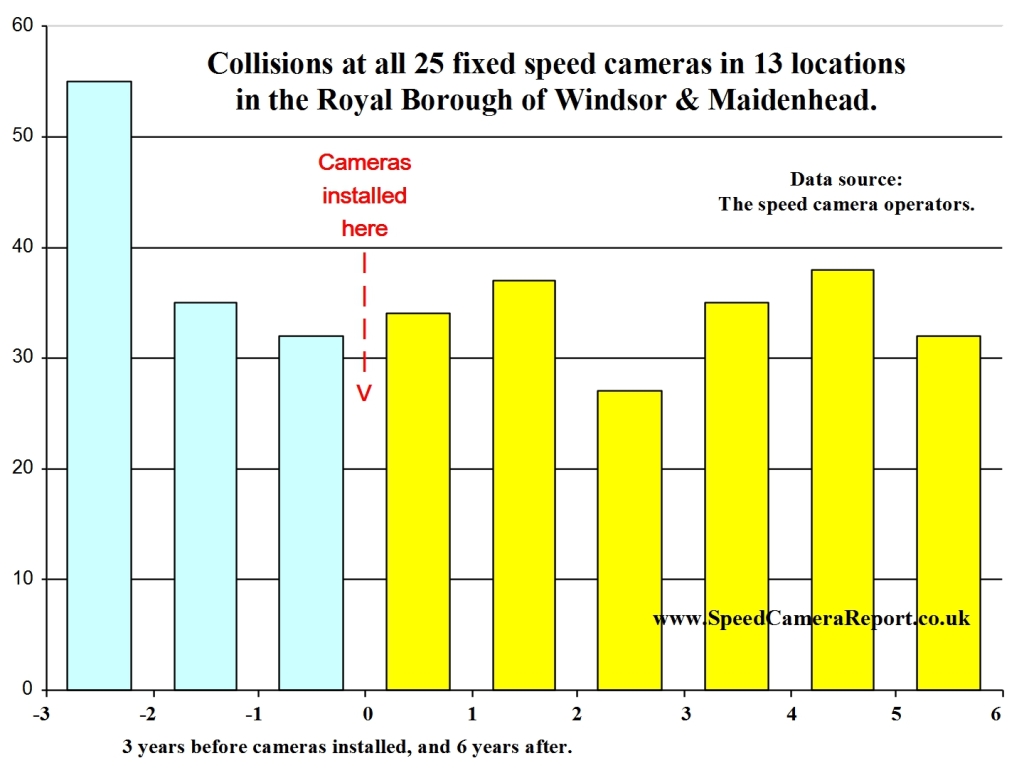This website presents the most accurate evaluation of speed cameras in the world.
All research is based entirely on official sources (such as the DfT and speed camera operators).
Everyone can therefore verify all the information for themselves.
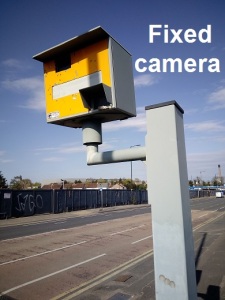
The evidence suggests that:
- Speed cameras do not save lives.
- Speed cameras do not prevent serious injuries.
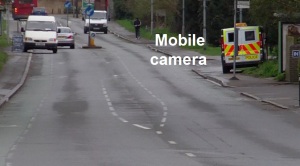
- In fact, deaths and serious injuries have increased following the use of both fixed and mobile speed cameras.
It’s the timing that’s important:
The speed camera partnership said there was:
- a 44% reduction in fatal and serious collisions at their mobile speed camera sites.
Sounds impressive but, by displaying those collisions on a graph, we can see when that reduction occurred. It happened a year before the cameras started operating.
- Speed cameras cannot have caused that reduction because they were not there when it occurred.
So what caused the reduction a year before the cameras?
The answer is that it’s caused by the site selection process and this effect is known as RTM (regression to the mean).
- To find out what RTM is and how to remove it: RTM.
- To see the full report with more detailed graphs: Mobile speed cameras.
There is a serious problem with official reports:
RTM is the most important factor at speed camera sites but official reports have consistently failed to remove all of the RTM effect from their results. This means that:
- the speed camera operators have never established what effect their cameras are actually having.
RTM is the focus of research presented in this website.
RTM is actually a very simple effect that occurs because camera sites are often selected following an unusually high number of collisions. Collisions then drop back to normal, whether or not cameras are eventually installed. This “return to normal” is called RTM.
To address RTM, I developed the FTP (four time periods) method. (RTM)
My new method is capable of both measuring the RTM effect, and completely excluding it from results. I applied it to mobile camera site data in Thames Valley to produce the worlds first report where the results do not include any RTM. This is therefore the 1st accurate report on the effects of speed cameras worldwide. (report)
My FTP method has now been endorsed by the DfT (department for transport) and, in his RAC Foundation report, Professor Richard Allsop recommended that it is the FTP method that should be used.
The investigations presented in this website lead to this recommendation:
Speed cameras must only be operated within scientific trials.
From the beginning:
When I first looked into speed cameras, I naturally expected to find that they did improve road safety and had no idea that what I discovered would lead to such detailed investigations. I read many official reports showing that collisions had reduced at the camera sites, but none of them established what caused the collisions. I therefore chose a speed camera at random and emailed the operators to find out. This quickly led to a surprising discovery. If I were to install speed cameras, I would first ask:
- “How many collisions involve a vehicle that was exceeding the speed limit?”
I can find no evidence that anyone thought to ask that question!
“Exceeding the speed limit” as a contributory factor in collisions:
Back in 1993 (when speed cameras were first used) Police investigated collisions, but they did not report “exceeding the speed limit” as a factor. They did eventually but not until 2005, after over a decade of speed camera operations. The Police found “exceeding the speed limit” occurred in less than 8% of all fatal and serious collisions.
This means that the vast majority (over 92%) of even the most serious collisions occur when drivers are not speeding. I put together a page showing evidence that the authorities have published. Don’t take anyone’s word for it, check for yourself from the official government sources (Speeding).
How to determine the effects of speed cameras directly (scientific trials):
There is a scientific trial called an RCT (randomised controlled trial). It is designed to find the effect of an ‘intervention’ in a ‘complex environment’ and it would tell us directly what effects speed cameras have. So what are the results of these trials? I was surprised to discover that:
- No speed cameras have ever been operated within scientific trials anywhere in the world.
Yet scientific trials are easy to run, this page explains them: scientific trials.
The 4YE (The national safety camera programme Four-year evaluation report).
The 4YE is the largest and most comprehensive speed camera report in Britain.
It states “42% fewer people were killed or seriously injured” at the camera sites, but here’s the puzzle:
- How can speed cameras cause a 42% reduction, when less than 8% involved a vehicle that was speeding?
The answer to this is actually in the 4YE, but it is very well hidden. Right near the end we find that most or all of that reduction would have occurred anyway (without the cameras), largely due to RTM. It turns out that:
- The evidence does not establish that speed cameras have saved any lives, or prevented any serious injuries.
This is surprising as the 4YE is the foundation of the entire speed camera programme. But don’t take anyone’s word for it, check the evidence for yourself from the official government source. (report)
The bit that confuses almost everybody, RTM (regression to the mean).
The authorities have really struggled with RTM. Early reports didn’t mention it and many don’t to this day. Some officials still try to deny that RTM even exists despite their own estimates that it is the largest effect at camera sites.
Even in the reports that do try to account for it, not a single one has managed to fully exclude RTM from it’s results, even though this is quite easy to do.
- I wrote a page to explain RTM, along with how to fully exclude its effect (RTM).
Road safety across the whole of Great Britain.
The speed camera programme is the largest and most expensive road safety policy ever implemented so we might expect to have seen the largest change in road safety across the country after the speed camera programme started. And we do. The trend in fatalities per billion vehicle miles (probably the most important road safety indicator) clearly changed when speed cameras started to be used, but it went the wrong way.
- The first 10 years of speed cameras saw the worst road safety improvements on British roads since the 1960s.
The situation only really started to recover in about 2007 (when the economic crisis started). Something clearly went seriously wrong with road safety as more and more speed cameras were deployed, but was it the speed cameras that caused the problem? Don’t take anyone’s word for it, check for yourself from the official government data (coming soon).
The royal borough of Windsor & Maidenhead (RBW&M):
In 2009, councillors in RBW&M were deciding whether to continue to pay £200,000 pa to the speed camera operators. They requested that I investigate the effectiveness of their 25 speed cameras at 13 locations.
The camera operators stated:
“… the casualty reduction record is impressive with a 44% drop in recorded injury collisions …”,
so I simply plotted those collisions on a graph. We can see that around half of that drop occurred 2 years before, and the other half over 6 years later. Speed cameras cannot cause a reduction before they are installed and, if they have failed to produce any reduction for 6 years, a reduction around 12 years later cannot be due to them.
Furthermore, serious injuries went up.
- There is no evidence that the 25 speed cameras in RBW&M have achieved any improvement whatsoever but don’t take anyone’s word for it, check for yourself from the official data supplied by the camera operators: Report and data.
Do speed cameras (fixed and mobile) prevent collisions? (report)
This is my first major report and it investigates the effect of speed cameras on the number of collisions at their sites. It includes a total of 317 camera sites across the whole of the Thames Valley area (212 fixed and 105 mobile).
The report concludes that:
- Speed cameras have not made any impact in preventing road traffic collisions.
- There was no reduction in the number of collisions at fixed (Gatso) camera sites after they were installed.
- There was no reduction in the number of collisions at mobile camera sites after they started operating.
- There was found to be no relationship between vehicle speeds and the number of collisions. Reductions in speeds at camera sites (both average and above the speed limit) did not result in any reduction in the number of collisions.
What effect do mobile speed cameras have on road safety? (report)
This is the worlds first speed camera report in which the final results do not include any RTM effects.
There was a 42% reduction in KSI (killed or seriously injured) at the 75 mobile speed camera sites in Thames Valley, but the entire reduction had already occurred a full year before the cameras started operating. The report concludes that the entire reduction was due to RTM, with the mobile speed cameras having provided no road safety benefit whatsoever. The final results compared the mean rates at the sites relative to all roads in Thames Valley before and after mobile speed cameras were deployed. There was:
- a 31% increase in KSI casualties.
- a 9% increase in all casualties.
The report concludes:
- The evidence suggests that the policy of using mobile speed cameras has contributed to more collisions, more serious injuries and more deaths on the roads where they operate.
What effect do fixed (Gatso-type) speed cameras have on road safety? (report)
This is the 2nd speed camera report in the world to have results that do not include any RTM effects.
The report evaluates the effect of fixed (Gatso-type) speed cameras in Thames Valley on the number and severity of collisions at the sites where they are installed.
After fixed speed cameras were installed at 212 sites, compensated for general influences and not including any RTM effects or seasonal bias, there was:
- a 38% increase in fatal collisions.
- a 16% increase in KSI collisions.
- a 0% change in all collisions.
The evidence suggests that:
- Reducing vehicle speeds using fixed speed cameras has no impact in improving road safety.
- Fixed speed cameras do not save lives and do not prevent serious injuries.
- Fixed speed cameras are not demonstrated to have reduced the number of collisions.
Recommendations:
- Speed cameras should only be operated within scientific trials.
- Increases in fatal and KSI collisions at speed camera sites should be independently investigated.
All information is believed to be accurate and presented honestly.
If any errors are found they will be corrected as soon as possible.
Please comment on the Message board.
Thank you,
Dave.
